INSTRUCTIONS TO CANDIDATES
- Write your Name and Index Number in the spaces provided above.
- Sign and write Date of examination in the spaces provided above.
- Answer ALL questions in the spaces provided.
- All workings MUST be clearly shown where necessary.
For Examiners use only.
| Question | Maximum Score | Candidates Score |
| 1 – 27 | 80 |

QUESTIONS
- The diagram below represents common laboratory equipment.
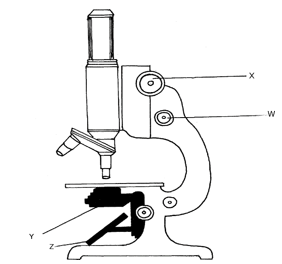
- Label the parts labeled X and Y. (2marks)
X ………………………………………………………..
Y………………………………………………………. - Using arrows show how the object is illuminated. (2marks)
- Label the parts labeled X and Y. (2marks)
- The Biological name of housefly is MUSCA DOMESTICA.
- State two mistakes in the way the biological (scientific) name is written. (2marks)
- Write the name in the correct manner following the rules of binomial nomenclature.(1mark)
- The diagram below show a structure used for gaseous exchange in an organism.
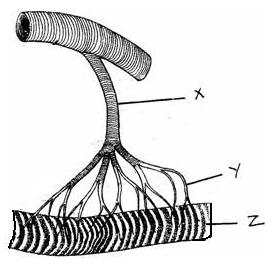
- Label parts. (3marks)
X ………………………………………………………………….
Y ………………………………………………………………….
Z …………………………………………………………………. - State the adaptation of part labelled Y. (1mark)
- Label parts. (3marks)
- Name the type of response exhibited by.
- Leaves of Mimosa pudica when they fold their after being touched. (1mark)
- Euglena when it swims towards the source of light. (1mark)
- Sperm cell when it swims towards the ovum. (1mark)
- Study the diagram below and answer the questions that follows.

- What is the phylum X? (1mark)
- Name the classes labeled a and b. (2marks)
a……………………………………………………………
b ……………………………………………………………
-
- Define population (1mark)
- From three students wanted to estimate the population of grasshoppers in 5km2 grass field near a school compound. They captured 36 grasshoppers and marked them before returning them back to the field. After two days they made another catch of grasshoppers. They collected 45 grasshoppers of which only 4 had marks.
- State why the second capture was done after two days. (1 mark)
- From the data calculate the population size of grasshoppers in the grass field.(2 marks)
- The set-up below was prepared by form one students and left for 1 hour
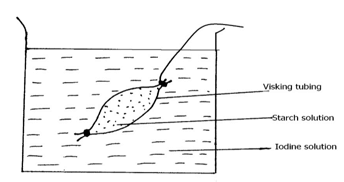
They made the following observations
At the start After one hour In visking tubing White solution Blue-black In beaker brown brown - Identify the physiological process being investigated (1mark)
- Explain the observation made (3marks)
- The equation below represents a reaction that occurs during respiration in a cell.
K + Phosphate → Adenosine triphosphate (ATP)- Identify the compound K. (1mark)
- State two differences between K and ATP. (2marks)
- Name the organelle responsible for the production of energy in a cell muscle (1mark)
- State three characteristics of cells at the zone of cell division in an apical meristem (3marks)
- The diagram below represents human foetus in the womb.
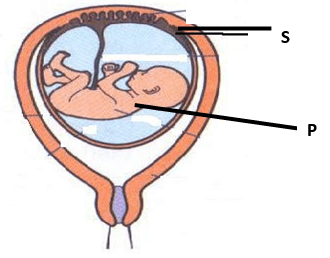
- Name the part labeled S and P (2marks)
S ……………………………………………………………………………………
P ……………………………………………………………………………………. - Give two reasons why you think the foetus is not yet due for birth (2marks)
- Name the part labeled S and P (2marks)
- Explain how the biceps and triceps muscles bring about the movement at the hinge joint of the elbow in man. (2marks)
- Part of one strand of DNA molecule was found to have the following sequence
G-C-C- G – A – T- T – T – A – C – G – G
What is the sequence on a:- Complimentary DNA strand? (1mark)
- m-RNA strand copied from this DNA portion? (1mark)
- Name two features that increase the surface area of the small intestines. (2marks)
- The diagram below shows two fused bones of a mammal.
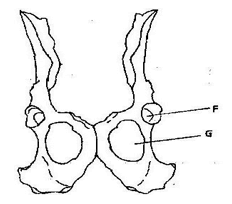
- Identify the fused bone. (1mark)
- Name the parts labeled F and G (2marks)
F…………………………………… G………………………………………. - Name the bone that articulates at the point labeled F. (1mark)
- A person was able to read a book clearly at arm’s length but not at normal reading distance.
- State the defect the person suffered from? (1mark)
- Why was he unable to read the book clearly at normal distance (1mark)
- How can the defect be corrected? (1mark)
- Give two functions of saliva in human digestion process (2marks)
- During a strenuous exercise the chemical process represented by the equation below takes place in the human muscle cells.
C6H12O6 → 2CH3CH(OH)COOH + 150KJ
(Substance X)- Name the process represented above. (1mark)
- Identify substance X (1mark)
-
- A mushroom research station would like to employ a researcher. Which scientist is most appropriate. (1mark)
- Name the branch of biology that deals with phylogenetic relationship between organisms.(1mark)
- Explain why plants absorb water in waterlogged soil but not mineral salts. (2marks)
- To control the spread of malaria, fish are introduced into water bodies near residential area.
- Name this method of population control. (1mark)
- State an advantage of the above method. (1mark)
- Explain why resistance to antibiotics is considered an example of evolution. (2marks)
-
- People are encouraged to take the corona virus disease vaccine. How does it work. (1mark)
- What is the significance of;
- Red blood cells lacking mitochondria. (1mark)
- Xylem vessels being dead. (1mark)
- A patient complained of frequent thirst. A sample of the patient’s urine was found not to have any sugar.
- Name the hormone the person was deficient of. (1mark)
- Name the gland that secretes the above hormone. (1mark)
-
- The paddles of a whale and fins of a fish adapt them to aquatic habitat.
- Name the evolutionary process that may have given rise do these structures.(1mark)
- What name is given to such structures. (1mark)
- State two advantages of natural selection. (2marks)
- The paddles of a whale and fins of a fish adapt them to aquatic habitat.
-
- Explain why ingestion of salty food may reduce the amount of water passed out in urine. (2marks)
- Explain why small birds puff their features when cold. (2marks)
-
- Explain why an effective respiratory system is associated with the circulatory system.(2marks)
- Distinguish between haemoglobin and myoglobin. (2marks)
- New born babies have a higher heart beat than adults. Explain why? (2marks)

MARKING SCHEME.
-
- X - Coarse Adjustment knob; Y – Diaphragm;
- Arrow to be on diagram
( AWARD A MARK FOR EACH ARROW DRAWN CORRECTLY)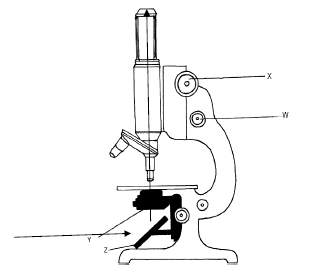
-
-
- The species name is written in capital letter;
- The two names are not underlined (separately) or italicized;
- Musca domestica;
-
-
- X – Trachea;
Y – Tracheoles;
Z – Muscles tissue; -
- Moist to dissolve gases;
- Large surface area for maximum gaseous exchange;
- well ventilated for bringing in fresh air rich in oxygen and for expelling used air rich in carbon (IV) oxide; (any one)
- X – Trachea;
-
- Nastic movement/Haptonasty/Thigmonasty;
- Phototaxis;
- Chemotaxis;
-
- Phylum Chordata;
- a – Pisces; b – Aves;
-
- Total number of organisms belonging to same species in a particular habitat at a particular time;
-
- To allow time for marked grasshoppers to mix freely/uniformly with the rest;
- From the data calculate the population size of grasshoppers in the grass field;(2 marks)
P = First capture x second capture; 36 x 45 = 405; grasshoppers
Marked recapture 4
-
- Diffusion;
- Blue black colour in the visking tubing;
Iodine molecules diffuses into the visking tubing as they are small in size therefore blue black colour;
Brown (Iodine colour) in the solution persisted because no starch could move out of the visking tubing as they are large in size;
-
- Adenosine triphosphate;
-
(Any two)k ATP Lower energy form Higher energy form; Has 2 phosphate groups Has 3 phosphate groups; Formed when ATP is hydrolyzed to release energy Formed by addition of one phosphate group; - Mitochondrion;
-
- Small in size;
- Dense cytoplasm;
- Prominent number;
- Thin cell wall;
- Lack vacuole;
- Actively dividing;
- Tightly packed;
- Cuboidal;
(Any three)
-
- S Amniotic Membrane; P Amniotic fluid;
-
- Closed up cervix;
- Unwidened cervix;
- Unbroken waters;
- Head not pointing the cervix;
(Any two)
- Biceps contract while triceps relax to bend the arm; Biceps relax while triceps contract to straighten the arm;
-
- C-G-G-C-T-A-A-A-T-G-C-C;
- C-G-G-C-U-A-A-A-U-G-C-C;
- Numerous villi and microvilli;
-
- Pelvic girdle;
- F – Acetabulum; G – Obturator foramen;
- Femur;
-
- Hypermetropia (long sightedness);
- Short eyeball or weak refractive power of the lens;
- Wearing of convex lenses;
-
- Contains salivary amylase acts on starch;
- Contains bicarbonate salts that provide alkaline pH for enzyme action;
- Contains water and mucus that lubricates and soften food for easy swallowing;
(Any two)
-
- Anaerobic respiration;
- Lactic acid;
-
- Mycologist;
- Evolution;
- Water absorption is by osmosis which does not require energy; mineral salts are absorbed by active transport that requires energy that depends on oxygen that is deficient in water logged soil;
-
- Biological control
- No pollution; No residual effect; (mark any one)
- The gene for resistance due to mutation is transmitted; hence creating a new population of resistant strains;
-
- Stimulates the body to make antibodies;
-
- Not to use up oxygen;
- Not to lose water to the neighboring cells;
-
- Antidiuretic hormone/ Vasopressin;
- Pituitary gland;
-
-
- Convergent evolution;
- Analogous structures;
-
- Allows survival of organisms with better qualities;
- Eliminates organisms with unfavorable traits;
-
-
- Salt increases osmotic pressure by blood; hence more water is reabsorbed from kidney tubules;
- To reduce heat loss; feathers trap more air that insulates against heat loss;
-
- Circulation system transports away the respiratory gases; creating a steep diffusion gradient;
- Haemoglobin- A protein found in the RBCs to transport oxygen; Myoglobin- A protein found in muscles that stores oxygen;
- Babies have a larger surface area to volume ratio hence they lose heat; require more oxygen for respiration to maintain body temperature at optimum;
Download Biology P1 Questions and Answers - Butula Sub-County Post Mock Exams 2021/2022.
Tap Here to Download for 50/-
Get on WhatsApp for 50/-
Why download?
- ✔ To read offline at any time.
- ✔ To Print at your convenience
- ✔ Share Easily with Friends / Students

